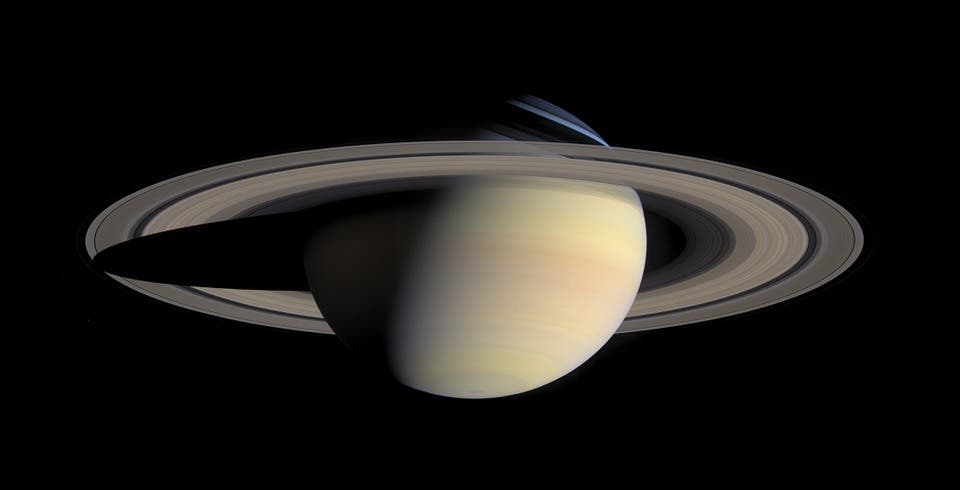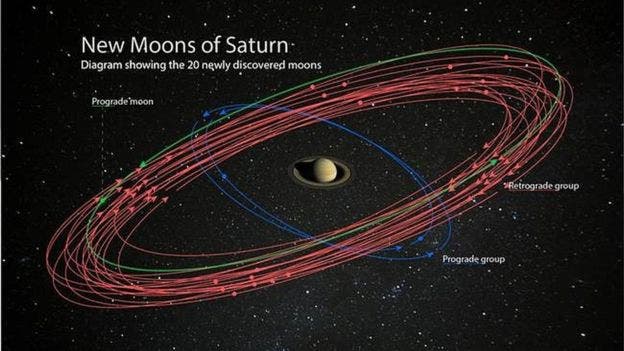A team of researchers from Carnegie just discovered 20 new moons orbiting around Saturn, raising the total count to 82 — barely surpassing Jupiter’s 79.

Depending on when you finished school, you might have learned that Jupiter or Saturn has the most moons. Kids finishing school this year will probably learn that Saturn has the most moons, as 20 new moons measuring around 5 km (3 miles) in diameter have been discovered around Saturn.
Three of these moons orbit Saturn “normally”, rotating in the same direction the planet does. The rest of 17, however, have a so-called retrograde rotation, meaning they rotate in the opposite direction.
“It’s exciting to find them,” said Scott Sheppard, an astronomer who led the work at the Carnegie Institution for Science in Washington DC. “These moons are very far away from the planet.” Each is about three miles across.

However, it’s not just a quirky new find or something topic students will have to learn — learning more about these moons could teach us something new about the evolution of their host planets, and the solar system as a whole.
“Studying the orbits of these moons can reveal their origins, as well as information about the conditions surrounding Saturn at the time of its formation,” said Dr Scott Sheppard, from the Carnegie Institution for Science in Washington DC, who led the team that discovered the moons.
Nowadays, if an asteroid zooms by a planet, the planet wouldn’t be able to capture it, because there’s nothing to slow it down and dissipate its energy. But in the solar system’s infancy, things were quite different.
In the early days of the solar system, when Saturn was still just forming, a cloud of dust and gas surrounded the planet. During those days, if an asteroid flew by Saturn, the cloud dissipated the asteroid’s energy, allowing the planet to capture the asteroid.
These moons have been alongside Saturn for a long time, it just took astronomers a long time to find them because they are so small.
These moons are at the very edge of what current satellites can discover — particularly, researchers used the Subaru telescope on Hawaii’s Mauna Kea volcano for their detection. From 2004 to 2007, Sheppard and colleagues used Subaru to sweep Saturn’s area looking for undiscovered moons. They did find some intriguing points of light, but it took a while to prove that they were in fact moons.
That’s why this discovery was more than a decade in the making. From 2004 to 2007, Sheppard and his colleagues used Subaru to comb the area around Saturn to search for undiscovered moons. While they did see some intriguing points of light, they struggled to prove that those pinpricks were, in fact, orbiting Saturn. It was improved computer algorithms that allowed astronomers to make the confirmation.
“We thought they were moons of Saturn, but we weren’t able to get full orbits to determine this,” said Dr Sheppard. “By using this new computer power, I was able to link these 20 objects that we thought were moons to officially find orbits for them.”
None of the new moons have names yet. Sheppard and colleagues have invited the public to offer suggestions for a period of 2 months, until December 6th.
Even without names, Saturn is, at least temporarily, the king of moons — overthrowing Jupiter from that position. However, that might not last for long. New, more powerful telescopes are currently being built, and there is a good chance that they will be able to discover even moons that are currently undetectable. Our current best capabilities allow astronomers to detect moons around 3 miles across around Saturn, and 1 mile across around Jupiter.






